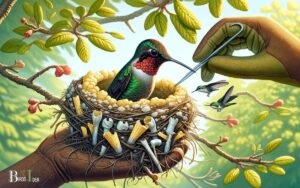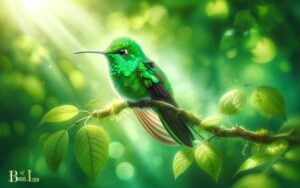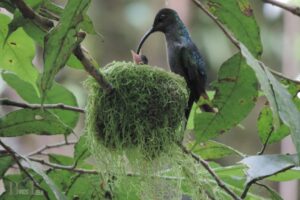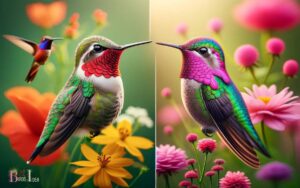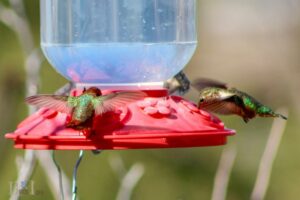What Type of Symbiosis Hummingbirds Feed on Nectar from Flowers?
Hummingbirds and the flowers from which they feed exhibit a mutualistic symbiotic relationship.
In a mutualistic symbiosis, both species involved benefit from the interaction.
For hummingbirds and flowers, the relationship works as follows:
This interaction helps ensure the survival of both the birds, which need the nectar to meet their high energy needs, and the flowers, which require pollination to reproduce.
An example of this is the relationship between hummingbirds and trumpet vine flowers. The shape and color of the flower are evolved to attract hummingbirds, and the flower’s structure facilitates the transfer of pollen onto the bird.
Here are some key points that highlight the aspects of this symbiotic relationship:
The interdependence between hummingbirds and flowers is a remarkable example of nature’s symbiotic intricacies, ensuring mutual survival and prosperity.
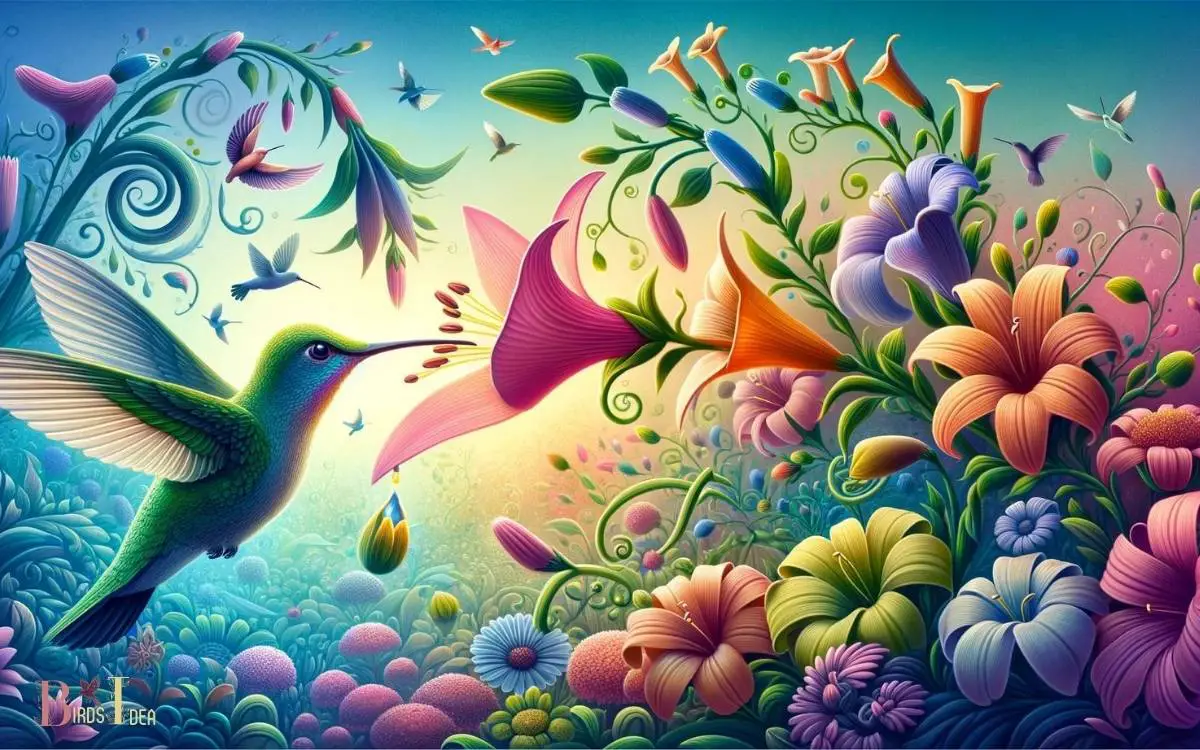
Key Takeaway
Hummingbird Feeding Behavior
When feeding on nectar from flowers, hummingbirds engage in a behavior known as nectarivory, which is a specialized form of feeding that involves the consumption of floral nectar as the primary food source.
This behavior is crucial for their survival as it provides them with the necessary energy to fuel their high metabolism.
Hummingbirds have co-evolved with flowers, developing specialized beaks and long, extendable tongues to efficiently extract nectar from deep within the blooms.
Their rapid wing movement allows them to hover in front of flowers while feeding, showcasing their remarkable agility and precision.
Additionally, their keen visual acuity enables them to locate and select flowers with high energy nectar, ensuring maximum nutritional benefit.
Overall, the hummingbird’s feeding behavior is a marvel of evolutionary adaptation, finely tuned for their dependence on floral nectar.
Nectar as a Food Source
Nectar serves as the primary food source for hummingbirds, providing the essential energy needed to sustain their high metabolism and agile flight.
Hummingbirds have evolved to be highly dependent on nectar due to its high sugar content, which supplies them with the necessary calories for their active lifestyle.
Additionally, nectar contains essential nutrients such as amino acids and vitamins that contribute to the hummingbird’s overall health.
The consumption of nectar also aids in the pollination of flowers, making hummingbirds an integral part of the ecosystem.
Furthermore, the unique composition of nectar allows hummingbirds to efficiently convert its energy into the rapid wingbeats required for hovering and quick movements, essential for their foraging and territorial defense.
Flower Adaptations for Hummingbirds
Adaptations in flowers for hummingbirds include specialized shapes and colors that have evolved to attract these avian species, facilitating the transfer of pollen and the continuation of the symbiotic relationship between hummingbirds and plants.
These adaptations are crucial for the successful pollination of flowers by hummingbirds.
The table below summarizes some common flower adaptations for hummingbirds:
| Adaptation | Description | Example |
|---|---|---|
| Tubular Shape | Allows for the hummingbird’s long bill to access nectar deep within the flower | Penstemon flowers |
| Bright Colors | Attracts hummingbirds from a distance | Red, orange, pink flowers |
| No Scent | Hummingbirds have a poor sense of smell, so no scent is needed | Bee balm flowers |
| Perching Points | Provides a place for the hummingbird to rest while feeding | Trumpet vines |
| Abundant Nectar | Ensures a good food source for the hummingbirds | Coral honeysuckle |
Coevolution of Hummingbirds and Flowers
Evolved over millions of years, the coevolution of hummingbirds and flowers has resulted in remarkable adaptations that have optimized the efficiency of nectar transfer and pollination.
This intricate process has led to several key developments:
- Specialized bill and tongue shapes in hummingbirds for extracting nectar from specific flower shapes and depths.
- Flower coloration and patterns that attract hummingbirds while providing visual cues for locating nectar.
- Synchronization of flowering times with hummingbird migration patterns, ensuring a mutualistic relationship.
- Production of nectar with the ideal sugar concentration to meet the energetic needs of hummingbirds while promoting effective pollination.
This coevolutionary dance between hummingbirds and flowers showcases the incredible harmony and mutual benefits that have evolved over time.
Pollination Process
The pollination process plays a crucial role in the life cycle of flowers, as it involves the transfer of pollen from the male reproductive organs to the female reproductive organs.
This process is often facilitated by the interaction between hummingbirds and flowers, showcasing a mutualistic relationship where birds obtain nectar while inadvertently aiding in the pollination of various plant species.
Understanding the intricate dynamics of this mutualism sheds light on the interconnectedness of ecosystems and the coevolution of hummingbirds and flowers.
Flower Pollination Process
Hummingbirds play a crucial role in the flower pollination process by transferring pollen between flowers as they feed on nectar.
This process is essential for the reproduction of flowering plants and the production of fruits and seeds.
The flower pollination involves several key steps:
- Nectar Feeding: Hummingbirds consume nectar from flowers using their long, specialized beaks.
- Pollen Transfer: As they feed, their heads and beaks come into contact with the reproductive parts of the flower, such as the stamens.
- Pollen Collection: Pollen grains adhere to the hummingbird’s head and beak.
- Pollen Deposition: When the hummingbird visits another flower of the same species, the pollen is deposited onto the flower’s reproductive structures, facilitating fertilization.
This intricate process highlights the vital role hummingbirds play in the pollination and reproduction of flowering plants.
Mutualism Between Birds
Playing a crucial role in the pollination process, hummingbirds contribute to the mutualism between birds and flowering plants.
As they feed on nectar from flowers, their heads come into contact with the reproductive parts of the plants, transferring pollen from one flower to another. This interaction benefits both parties involved.
The flowering plants receive the advantage of cross-pollination, which leads to genetic diversity and improved reproductive success. In return, hummingbirds obtain a rich source of nectar, meeting their nutritional needs.
This mutualistic relationship has evolved over time, with both birds and flowering plants adapting to each other’s characteristics and behaviors to maximize the benefits gained.
Understanding the intricate dynamics of this mutualism provides insight into the delicate balance of nature’s interconnected ecosystems.
Attraction Mechanisms
When feeding on nectar from flowers, hummingbirds are attracted to certain plants through the use of specific visual and olfactory cues.
These attraction mechanisms play a crucial role in guiding hummingbirds to the flowers that provide the necessary nectar for their sustenance.
The following cues are instrumental in attracting hummingbirds to flowers:
- Brightly colored flowers, particularly red, orange, and pink, are visually appealing to hummingbirds.
- Tubular-shaped flowers are well-suited to the unique beak structure of hummingbirds, making it easier for them to access nectar.
- Flowers with a strong, pleasant fragrance attract hummingbirds through their keen sense of smell.
- The presence of ample nectar within the flowers is a crucial factor in attracting hummingbirds.
These visual and olfactory cues work in harmony to create a compelling attraction for hummingbirds, ensuring their continued visits to the flowers for nectar.
Symbiotic Relationship Benefits
The symbiotic relationship between hummingbirds and flowers benefits both parties through mutualistic nectar exchange and pollination.
Hummingbirds receive a nutrient-rich food source while aiding in the pollination of flowers, which in turn aids in plant reproduction.
This mutualistic relationship highlights the interconnectedness and interdependence of species in the ecosystem.
Mutualistic Nectar Exchange
Mutualistic nectar exchange between hummingbirds and flowers provides essential nutrients for the birds while facilitating the pollination of flowering plants.
This symbiotic relationship benefits both the hummingbirds and the flowers in several ways:
- Nutritional Benefit: Hummingbirds obtain essential sugars and amino acids from the nectar, which are crucial for their high metabolic rate.
- Pollination: As hummingbirds feed on nectar, they inadvertently transfer pollen from one flower to another, aiding in the reproduction of the plants.
- Floral Attraction: The bright colors and distinct shapes of flowers attract hummingbirds, ensuring their continued visits for nectar.
- Species Diversity: This mutualistic exchange contributes to the diversity of both hummingbird species and flowering plants, promoting a balanced ecosystem.
Pollination Aids Plant Reproduction
Symbiotic nectar exchange between hummingbirds and flowers significantly aids in plant reproduction through the unintentional transfer of pollen as the birds feed on nectar.
This process, known as pollination, is crucial for the reproductive success of many flowering plants.
When hummingbirds feed on nectar, their heads and beaks inadvertently come into contact with the reproductive parts of the flowers, such as the stamens and pistils, picking up and depositing pollen as they move from flower to flower.
This unintentional transfer of pollen facilitates fertilization, leading to the production of seeds and the formation of fruits.
In this way, hummingbirds play a vital role in the reproductive cycle of many plant species, contributing to genetic diversity and the overall health of ecosystems.
Impact on Ecosystem
Hummingbirds’ feeding on nectar from flowers has a significant impact on the ecosystem. This impact is multifaceted and plays a crucial role in maintaining the balance of the ecosystem.
The following are some of the ways in which hummingbirds’ feeding habits influence the ecosystem:
- Pollination: Hummingbirds are important pollinators for many flowering plants, facilitating their reproduction and contributing to the overall biodiversity of the ecosystem.
- Plant distribution: By feeding on nectar and spreading pollen, hummingbirds help in the dispersal of plants, influencing the distribution and diversity of flora within the ecosystem.
- Predation control: Hummingbirds also act as natural predators of insects, helping to control insect populations within the ecosystem.
- Ecotourism: The presence of hummingbirds, attracted by flowering plants, can contribute to ecotourism, benefiting local economies and conservation efforts.
Conservation Efforts
An essential component of conservation efforts for maintaining the delicate balance of ecosystems involves implementing strategic measures to protect the habitats and food sources of hummingbirds.
This includes preserving and restoring the natural habitats where hummingbirds find nectar-producing flowers, as well as ensuring the availability of these floral resources.
Conservation organizations and government agencies work to establish protected areas, such as wildlife reserves and botanical gardens, where native plants and flowers can thrive undisturbed.
Additionally, efforts to reduce habitat destruction and mitigate the impact of climate change on these ecosystems are crucial.
Collaborative initiatives involving local communities, scientific research, and public education play a vital role in raising awareness and garnering support for the conservation of hummingbird habitats and their food sources.
These efforts are essential for safeguarding the intricate relationship between hummingbirds and the flowers they rely on for sustenance.
Conclusion
The symbiotic relationship between hummingbirds and flowers is a remarkable example of coevolution in nature.
The intricate dance of the hummingbird feeding on nectar from the flowers, while unknowingly assisting in the pollination process, creates a beautiful and harmonious image of interdependence in the ecosystem.
This mutualistic relationship not only benefits the survival of both species, but also plays a crucial role in maintaining the biodiversity and balance of the natural world.

